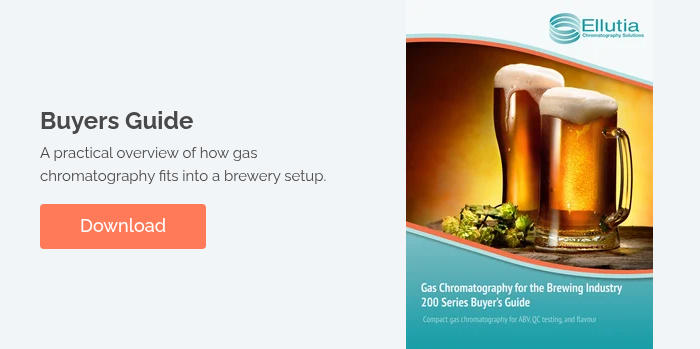Measuring ABV in Beer
Application Note:
ABV testing in beer using gas chromatography.
Introduction
Accurate alcohol measurement matters at every stage of brewing. Even small differences in %ABV can affect flavour, consistency, labelling, and duty calculations. Many brewers still rely on hydrometers or refractometers to estimate alcohol content, but those methods can give misleading readings once fermentation begins. Sugars, carbonation, and other dissolved compounds affect density, making it hard to know exactly how much ethanol is present.
Gas chromatography provides a direct way to measure ethanol. It gives precise, repeatable %ABV results that help brewers confirm label accuracy, maintain quality, and keep production running smoothly.

The Challenge
Why traditional testing often falls short
Density-based testing estimates alcohol content by comparing the liquid’s gravity before and after fermentation. In theory this works, but in practice beer contains more than just water and ethanol. Sugars, acids, carbonation, and proteins all influence density, which means even a small variation in composition can affect the result.
External lab testing is another option, but it introduces delays and extra cost. When you need to confirm a batch before packaging or shipping, waiting for results can slow everything down.
Brewers need a fast and reliable way to measure ethanol directly, without relying on calculations or assumptions.

The Solution
Measuring ethanol in beer with gas chromatography
Gas chromatography solves the limits of density-based testing by measuring ethanol directly. The result is a true %ABV value that is consistent, accurate, and traceable.

With the Ellutia 200 Series GC, brewers can analyse beer samples on-site in minutes. The system provides reliable data for quality control, record keeping, and duty compliance. By testing in-house, breweries can check alcohol levels whenever they need to, without waiting for third-party results.
Gas chromatography separates every compound in the sample. Ethanol is measured independently of sugars, carbonation, or other ingredients, giving a clear and dependable reading every time.
If you’d like a practical overview of how gas chromatography fits into a brewery setup, take a look at the 200 GC Buyers Guide for Breweries.
Method Overview
How beer is tested using gas chromatography
Once the system is set up, the process is straightforward. A small beer sample is prepared, calibration standards are run to create a reference curve, and the instrument measures ethanol directly against that curve.
Before testing, the beer is degassed by gently pouring it between two beakers to remove dissolved CO₂. This prevents bubbles from affecting the injection. If the sample appears cloudy, it can be filtered to remove particulates before analysis.
Calibration standards are prepared using ethanol in water, covering concentrations from 0.01% to 10%. These standards define the calibration curve that the instrument uses to calculate ethanol content.
The method uses the following GC conditions:
- Column: EL-5, 30 m × 0.25 mm × 0.25 µm
- Injector: 250 °C, split mode, 0.5 µL injection
- Detector: FID at 300 °C
- Oven program: Start 100 °C (hold 0.1 min), ramp 20 °C/min to 170 °C (hold 1 min)
Watch
How to Prepare Calibration Standards for ABV Testing in Beer
Learn how to prepare ethanol calibration standards for measuring alcohol content in beer. This step-by-step guide explains how to mix, dilute, and store standards that produce an accurate calibration curve for GC analysis.
How to Measure ABV in Beer Using Gas Chromatography
See the full process for analysing alcohol content in beer using the Ellutia 200 Series GC. This video walks through the setup, sample injection, and analysis, showing how to measure ethanol directly for clear, reliable %ABV results.
Results and Reliability
What the results show
After calibration, the ethanol curve showed a smooth, linear response across the full range, with an R² value of 0.9999882. This confirms stable detector performance and reliable quantification.
When a beer sample labelled at 3.4% ABV was tested, the measured value was 3.408% v/v. The chromatogram displayed a clear ethanol peak with a flat baseline, showing that the method can detect and measure ethanol with precision.
Testing beer with gas chromatography gives brewers accurate, traceable data for every batch. You can confirm label values, check consistency between brews, and maintain clear records for duty reporting. The process is quick, dependable, and repeatable, keeping production efficient and consistent.
Learn More
Get the full method and results
If you’d like to see the full details behind this testing method, you can download the complete application note. It includes chromatograms, calibration data, and the exact conditions used for the analysis. It’s a handy reference if you want to check your own setup or compare results.
Download the full application note.
It only takes a few moments to signup.
Frequently Asked Questions
-
How is beer tested for ethanol content?Beer can be tested using gas chromatography. The method separates compounds in the sample so ethanol can be measured directly instead of estimated from density. This provides an accurate %ABV result.
-
Why can hydrometer readings be unreliable for beer?Sugars, acids, carbonation, and residual extract all affect density. That means the difference between original and final gravity may not accurately reflect true ethanol content.
-
Can gas chromatography be used on-site in a brewery?
Yes. Compact systems such as the Ellutia 200 Series GC make it possible to measure ethanol accurately in your own brewery. This removes the need to send samples to external labs and allows faster decision-making before packaging.
-
How long does a gas chromatography test take?Each run typically takes just a few minutes. Once the instrument is calibrated, results can be reviewed almost immediately.
-
What else can the 200 Series GC be used for in brewing?Alongside alcohol-free testing, the same system can be used for flavour profiling and volatile compound analysis, helping brewers control both product quality and consistency.



